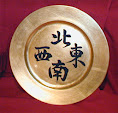Also, we’ve been used to using “professions” and “cultural backgrounds” from later incarnations of the game and from its sister publications, and forgotten (at least it was my case) how deeply “Old School” the RQ2 char-gen was, with its focus on adventurers’ organisations and on repaying back debt by looting dungeons...
Anyway, I present you here for your enjoyment (and, hopefully, for actual use) a summarised RuneQuest Classic Edition Character Generation primer, perfected with the help of the jolly RQ2 G+ community.
STEP 1 – Characteristics
Roll the character’s seven characteristics according to their race (roll 3D6 for each characteristic for a human character; see Chapter VIII of RuneQuest Classic Edition for other races):
- STR ⓘ
- CON ⓘ
- SIZ
- INT
- POW
- DEX ⓘ
- CHA
ⓘ: can be increased by training, see step 7 below.
STEP 2 – Abilities and other Derived Characteristics
STEP 2a – Abilities
Compute abilities according to section A of the Classic Handouts.
- Attack (skill category bonus)
- Parry (skill category bonus)
- Defence
- Hit Points (Total HPs + Hit Points per Location using the table in section A of the Classic Handouts)
- Damage Bonus
- Perception (skill category bonus)
- Stealth (skill category bonus)
- Manipulation (skill category bonus)
- Knowledge (skill category bonus)
Note 1: the Oratory skill does not fall in any of the previous categories.
Note 2: Should any of the character’s characteristics be increased by training, please do not forget to re-calculate the character’s abilities.
STEP 2b – Other Derived Characteristics
- Movement (always equal to 8 for humans; see Chapter VIII of RuneQuest Classic Edition for other races)
- Maximum Encumbrance, average of STR and CON, but capped by the character’s STR
- Strike Rank Modifier, per the table in section A of the Classic Handouts.
STEP 3 – Starting Money
Roll according to section A of the Classic Handouts.
SPECIAL – Creating a Shaman Character
Becoming a shaman is so time-consuming that the character cannot undergo any other training (i.e., skip Steps 4 to 7). Please refer to pages 44 to 46 of RuneQuest Classic Edition.
STEP 4 – Compute Combat Skills
STEP 4a – Starting Combat Skills
The basic chance of all weapon skills is 5%, except when indicated otherwise (see section A of the Classic Handouts).
STEP 4b – Get Credit
These skill increases may be bought using the character’s starting money. However, since this amount is usually very low (and thus insufficient), a character may obtain credit from the various guilds; the credit is equal to STR × 100L.
STEP 4c – Increase Combat Skills
See tables on p26, p30 and p31 of RuneQuest Classic Edition.
STEP 5 – Compute Non-Combat Skills
STEP 5a – Starting Non-Combat Skills
The basic chance of each skill is indicated in the various tables in section D of the Classic Handouts.
Note that alchemical skills are not expressed in percentages.
STEP 5b – Get Credit
A character may obtain credit from the Thieves Association; the credit is equal to DEX × 100L. This credit may only be used to purchase thieving skills. Other guilds/crafts do not offer credit, and require apprenticeship in order to receive credit for training during character generation (see Appendix H of Chapter X of RuneQuest Classic Edition for more details on this).
STEP 5c – Increase Non-Combat Skills
See section D of the Classic Handouts.
Contrary to combat skills, non-combat skills are only taught by some guilds, which may have special requirements:
- Becoming an associate member of the Alchemists Guild costs 5,000L. This is a pre-requisite to learning any of the alchemical skills.
- Becoming an associate member of the Armourers Guild costs 5,000L. This is a pre-requisite to learning any of the armourers’ skills.
STEP 6 – Purchase Battle Magic
Credit from cults for Battle Magic spell purchases = POW × 100L.
See section H of the Classic Handouts.
STEP 7 – Increase Characteristics by Training
STR may be increased by spending 1,000L per STR point.
CON may be increased by spending 2,000L per CON point.
Neither STR nor CON may be raised above the highest of STR, CON, SIZ before any modifications are applied.
DEX may be increased by spending 1,000L per DEX point.
DEX can be raised up to the racial maximum.
STEP 8 – Equipment
Starting equipment depends on the background rolled at Step 3.
What the character may purchase depends on the amount of money rolled at Step 3, and whatever credit money they have left from Steps 4 and 5.
PREVIOUS EXPERIENCE – Appendix H of Chapter X of RuneQuest Classic Edition presents an optional system of previous experience for player characters.













Thank you for this very useful post.
ReplyDeleteThank you very helpful!
ReplyDeleteI have the original and the classic books for RQ2 and neither version gives a limit for defence. Have you seen any official rule?
ReplyDeleteI don't think there is any limit. But as someone who has played RQ2 for a very long time, I have never seen Defence rise past 30/35% -- remember it's quite difficult to improve (you only get to roll an increase if the attack missed by the defence margin, and you only roll the increase under your INT as a percentage).
DeleteMy first-ever RQ pc was (largely by accident) Defense-minmax'ed; the GM remarked that my beginning Def was bigger than he'd ever seen in-play. I ran him for a few dozen sessions -- which isn't all that many, really -- and got him up to (IIRC) 40%-45% Defense.
DeleteNote that it's an accelerating curve -- the bigger your Def, the more-often you get a roll; and with a big INT, you succeed roughly 1 in 5 of those rolls.